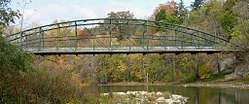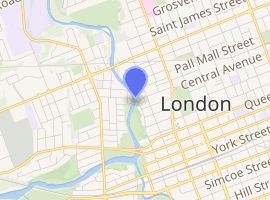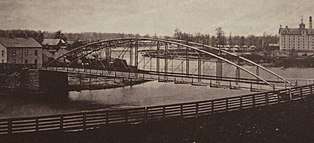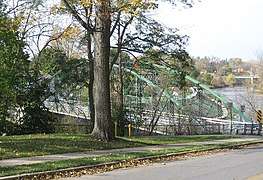Blackfriars Street Bridge
Blackfriars Bridge in London, Ontario, Canada is a wrought iron bowstring arch through truss bridge, crossing the North Thames River. The bridge was constructed in 1875 and carries single-lane vehicles, bicycles and pedestrians from Blackfriars Street to Ridout Street North.
Blackfriars Street Bridge | |
|---|---|
 | |
| Coordinates | 42°59′20″N 81°15′26″W |
| Carries | 1 lane of roadway Pedestrians and bicycles |
| Crosses | Thames River |
| Locale | London, Ontario |
| Owner | City of London |
| Characteristics | |
| Design | Bowstring truss Pin connections and lattice girders |
| Material | Wrought iron, wood deck |
| Total length | 212ft, 64.6m (unsupported length) |
| History | |
| Constructed by | Isaac Crouse |
| Fabrication by | Wrought Iron Bridge Company |
| Opened | 1875 |
| Rebuilt | 2018 |
| Designated | September 8, 2008 |
| Type | Bridge |
| Designated | April 21, 1992 |

| |
At 216 feet (65.8 meters) it is the longest working span of that kind in North America.[1] (It has been erroneously referred to as "Blackfriars Street Bridge", though the naming of the bridge preceded the naming of Blackfriars Street.)
Description
The Blackfriars Bridge is the oldest wrought iron bridge in North America still used for vehicular traffic.[2] The construction of the bridge is made in a bowstring truss design that uses pin connections and lattice girders.
The deck surface is presently of renewable planking: a double file of approximately 1,500 8ft 2'x4' each, on edge, upon a framework of nine longitudinally laid stringers of 1ft iron I-beams, topped with bolted-on wooden cladding, whose ends rest on the two abutments. Attached beneath these are 15 transverse floor-beams, from which vertical lattice pillars, under tension, translate the live thrusts of traffic to the bowed upper chord, which transfers this back as tension along the bottom-chord "string" of the bow. This bottom chord consists of two sets of four 10 cm x 3 cm wrought-iron eyebars, running along, outside, both sides of the deck. Although originally two-lane, due to the weight and frequency of modern traffic, the Blackfriars is at present two-way but single-lane. Because of damage to the wooden deck surface and to the iron structure, it has been closed to automobile traffic since 2013.
The Bridge is sited at the east end of a short Blackfriars Street,[3] which turns sharply south and up a slight grade, as the downtown Ridout Street, upon crossing it. To the bridge's west is the lower ground of the previous town of Petersville, protected by an extensive dike embankment, due to a history of flooding; to its east a terrace rises above the North Thames River to central London.[4] The river there is bordered on both sides by extensive bicycle and walking paths, and the Bridge is well framed by a variety of second-growth trees.
Although originally two-lane, due to the weight and frequency of modern traffic, the Blackfriars is at present two-way but single-lane. Because of damage to the wooden deck surface and to the iron structure, it has been closed to automobile traffic since 2013.
History
The Blackfriars Bridge was manufactured by the Wrought Iron Bridge Company (WIBC) of Canton, Ohio, although erected by local London contractor Isaac Crouse. There is evidence for its being prototypical for a revised design by WIBC, incorporating a double-panel web.[5] The bridge is the successor to a series of fixed, wooden structures at the site since 1831, which were damaged mainly by spring freshets of the river.[6]
It is the northernmost and oldest of a company of eight bridges of different ages, constructions and uses,[7] surrounding the confluence of the North Thames and Thames rivers, which fixes the historic center of London.
The significance of the bridge is due to the age, type, material and rarity. According to bridge historian Nathan Holth,

Bowstring bridges are one of the rarest types of truss bridges, and most date in the 1870s. They fell out of favor due to the limited weight they could support. Any bowstring truss bridge that survives today is a miracle. Truss bridges are always intricate structures, but bowstring trusses are even more so. There [are] lattice, v-lacing, and members all over. This large amount of complexity is balanced by the simple, graceful appearance of the arched top chord. The result is a bridge with incomparable beauty and appeal. Among the rarest and oldest bridges in Canada is this breathtaking iron bowstring truss. Keystone Columns form the top chord. A sidewalk on the south side appears to be original.[8]
It has been designated a historic structure under Part IV of the Ontario Heritage Act.
Closure to vehicular traffic

The bridge was closed to all traffic on 13 May 2013, for the purpose of extensive infrastructural assessment and repair, with plans to re-open it by August 2013.[9] Due to the extent and cost (approximately $3M) of repairs required, the closure was extended indefinitely, and subsequently re-opened to pedestrian traffic in December 2013.[10] Access has been restricted to a pedestrian pathway by using temporary fencing, pending an environmental assessment to determine whether it will be feasible to re-open the bridge to vehicular traffic. As of June 2017, the bridge has been listed as under repair, with plans to reopen it to East bound only traffic, cyclists and pedestrians, to officially reopen in 2018-2019.
Restoration
In 2017, a $7.9m plan was started, for a rebuild of the bridge.
On November 27, 2017, the bridge was cut in half, and lifted to the banks of the Thames, for moving to an off site location for refurbishment.[11] After one year of rehabilitation, the Blackfriars Bridge was reopened to pedestrians, motorists and cyclists immediately following a grand opening celebration on Saturday, December 1, 2018.[12]
Natural and cultural aspects
Much of the beauty and appeal of the bridge is its appearance of floating (from many profile views up and downstream on both banks of the gently winding river). That is owed to its strung-bow shape and its light placement at its very tips upon modest granite abutments — a feature rare among more modern tied-arch bridges. These abutments bear the passive vertical load of the open structure itself. However, the varying 'live' thrust forces of traffic downward on its deck are translated by the bowed chord above into horizontal tensions along the longitudinal iron eyebars of the 'string' or bottom chord running parallel to the deck.

The Blackfriars Bridge has figured in various artistic works, visual and literary, including a series of stained glass windows by Ted Goodden. Nathan Holth praises the City of London and the Province of Ontario for maintaining its old iron bridges. Regarding the nearby, larger pony-truss Kensington Bridge he praises the City for "keeping the Thames River looking wild and natural," even near its center, with the look of "a rural bridge in an urban environment, which further enhances the beauty of the bridge", a remark that would apply as well to the Blackfriars. With recent improvement of the rivers, wild nature seems to confirm the point. (See, below, resident Great blue heron in winter.)
References
- F. Michael Bartlett and Dana R. Tessler, "Wrought-Iron Bowstring Bridges: The One-Hit Wonder of the 1870s", 7th International Conference on Short and Medium Span Bridges, 2006, Montreal. For discussion of other extant bowstrings in the North American Midwest, see Holth "Archived copy". Archived from the original on 2008-05-13. Retrieved 2008-05-24.CS1 maint: archived copy as title (link)
- "Blackfriars Bridge". Canada Historic Places.
- Though long enough to be the childhood home of Academy-Award winning screenwriter, director, producer, actor Paul Haggis, whose production company is named "Blackfriars Bridge Films". See IMDb listing .
- The broad, shallow valley of the Thames is the path of the westerly-flowing meltwater of glaciers from the last ice age, ca 15,000 years BP. (See Thames River (Ontario).) For information on Petersville and the flood, see "History", London, Ontario.
- The bridge is one of the first to feature a 'double-panel' web diagonal arrangement that was patented in America one year after the bridge was constructed…. The patent highlights the structural contribution of these members… and because their participation can only be accurately assessed using modern computer analyses, Blackfriars Bridge may have been built as a prototype to validate the double-panel design feature." F. M. Bartlett, J. M. Graham and J. Camiletti, "1870s Innovation in London Canada Blackfriars Bridge", "Proceedings of the Institution of Civil Engineers" (EH003, 2009): 1-7. This allows the substitution of verticals rods for posts in the center.
- London Free Press (28 September 1875). In 1861 that newspaper had reported that in a "freshet" of almost twenty feet a wooden bridge "...erected by subscription last fall..." was carried away in a day. This was the only river crossing to the north: thus the iron bridge investment of $10,000 in 1875 (ca $180,000 today).
- These include two pony-truss bridges, the Kensington and the Victoria (the Ridout Street crossing of the other river branch); a Pratt (see truss bridge) deck-truss, iron, railroad bridge; and the little metal-pinned, Pratt, through King Street Bridge (1895), now a pedestrian walkway. See Holth, Archived 2007-09-27 at the Wayback Machine.
- Nathan Holth, "Historic Bridges.org" Archived 2007-08-22 at the Wayback Machine. This site features a map and many structural photographs of the Bridge, with close commentary expanding on the details cited here. The raised pedestrian guardrail is likely owing to the original's being less than 31 inches or 80 cm above an outward sloping snowpack after heavy snows.
- http://www.am980.ca/2013/08/22/blackfriars-bridge-closed/
- http://london.ctvnews.ca/blackfriars-bridge-reopens-to-pedestrians-cyclists-1.1600968
- http://www.cbc.ca/news/canada/london/blackfriars-bridge-removed-1.4420328
- http://www.london.ca/residents/Roads-Transportation/infrastructure-road-projects/Pages/blackfriarsbridge.aspx